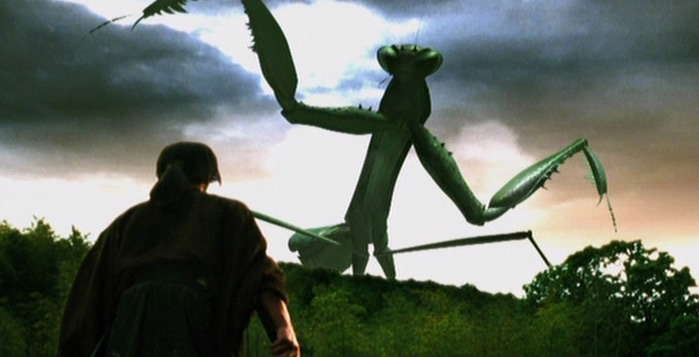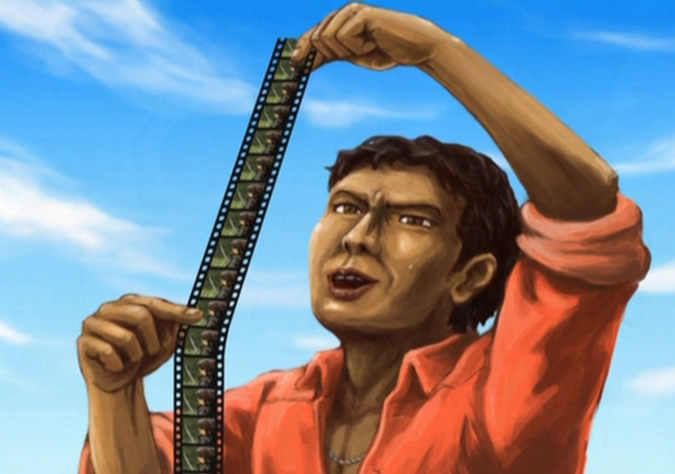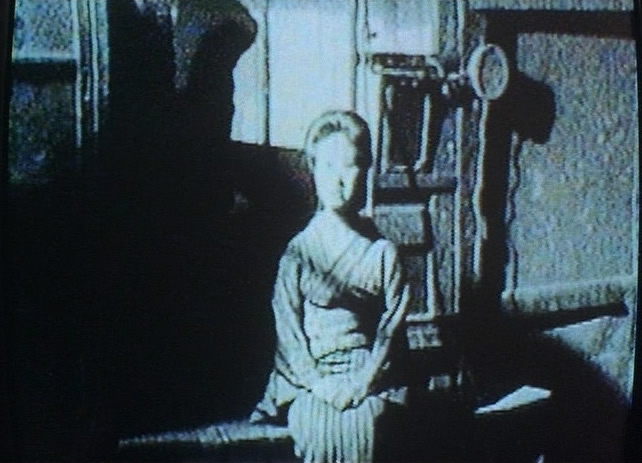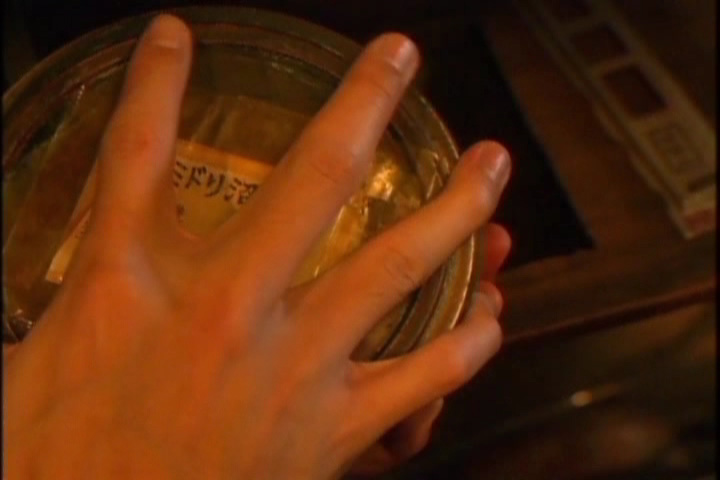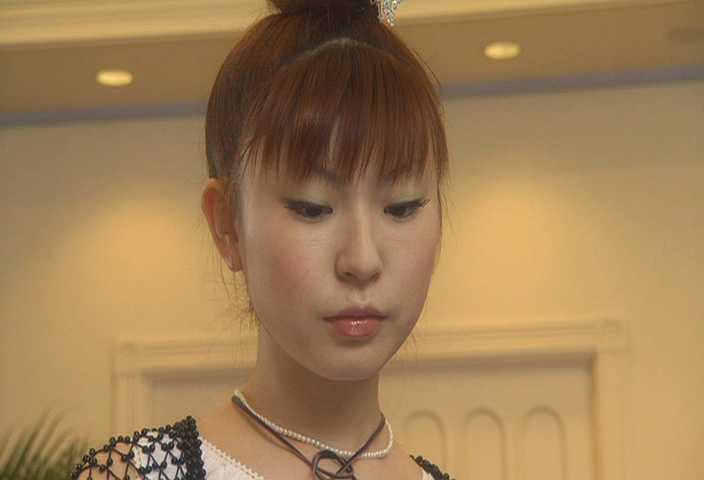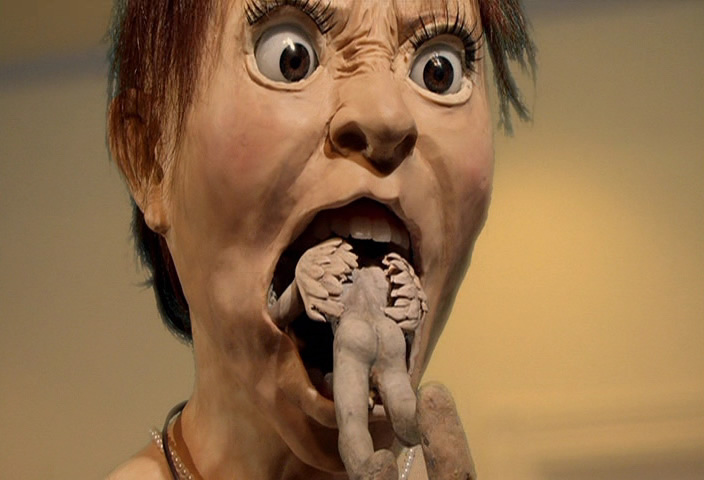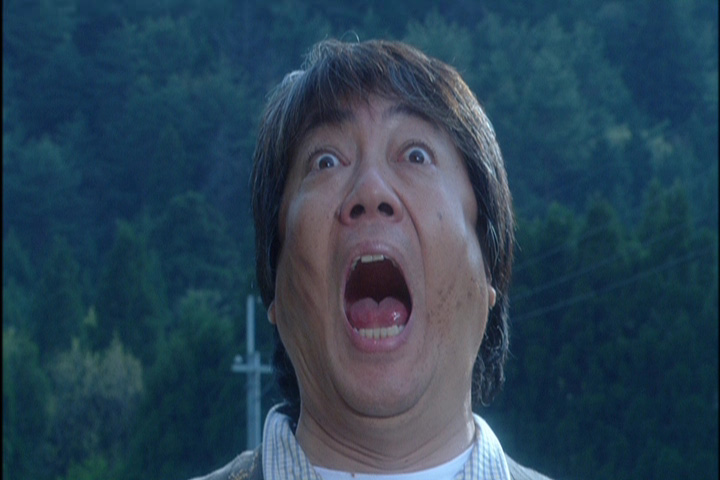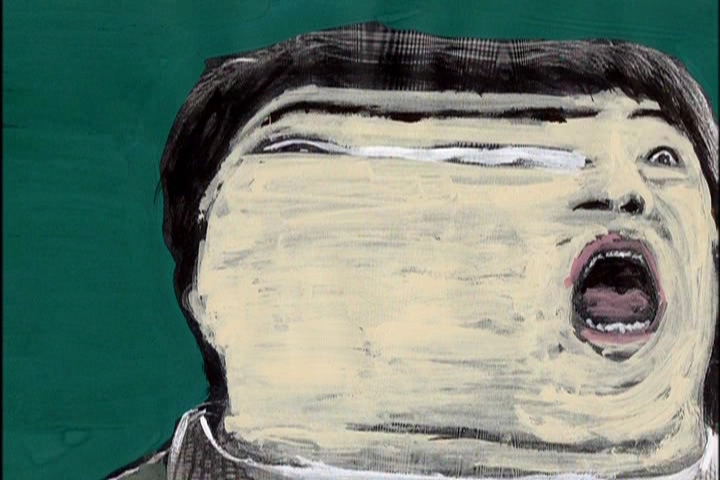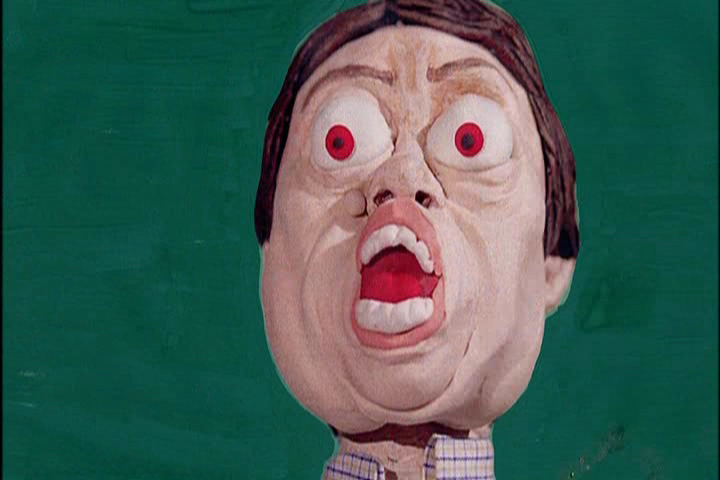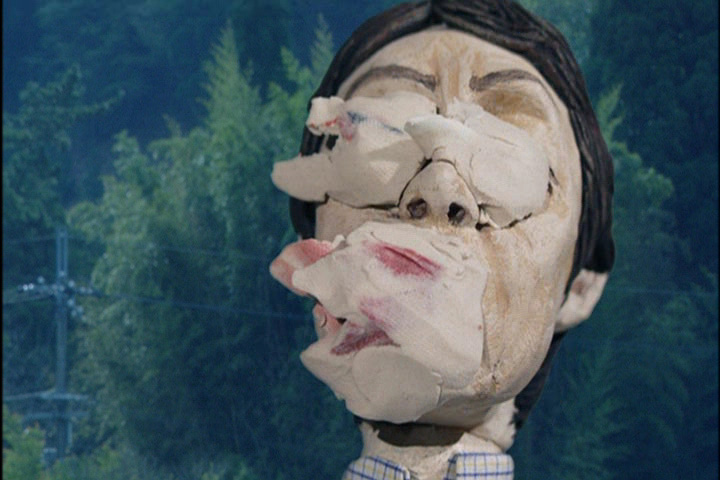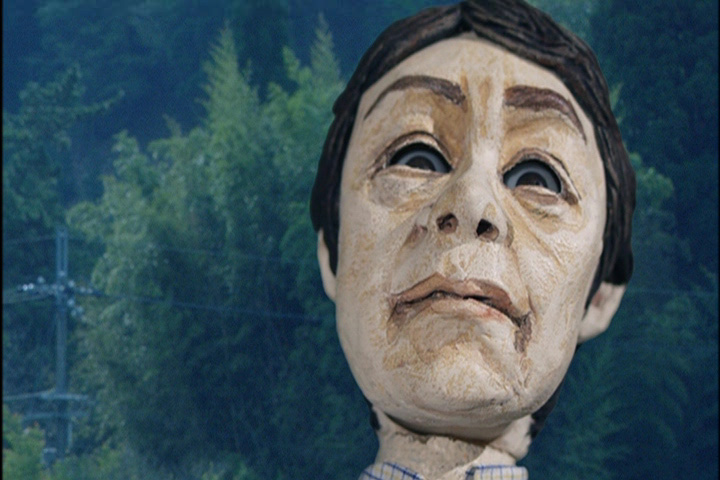Between Frames: Japanese Cinema at the Digital Turn
Laura Lee
The advent of digital media and the perceived danger it has implied for the status of cinema have resulted in an inevitable nostalgia for the unique properties of the latter. In many Japanese films at the digital turn this manifests itself as a staging of the cinematic apparatus, in which cinema is refracted through composite media arrangements. [1] These films layer various media forms in a manner that ensures their visual distinctiveness and thus their perceptual differentiation from one another. This article demonstrates that the appearance of these hybrid media arrangements in popular cinema is strongly connected to the prominence of the cinematic apparatus—most commonly to the foregrounding of the filmic mechanism through the exploitation of its spatio-temporal interval, or the space between photograms. Although the cinematic apparatus is founded on the illusion of continuity and seamless movement arising from discontinuous, static frames on the filmstrip, theoretically, at least, the structure underpinning the medium is perpetually obscured. Because this is generally true, the visibility of the cinematic interstices in many contemporary Japanese films becomes a citation of cinema, laying bare the medium. [2] Furthermore, since this interval between individual photographic frames overlays the gap between different media in many contemporary films, the basic unit of the cinematic mechanism is in effect displayed at a medial remove. Images highlighting the cinematic interval are bracketed off in these films, its unique textures highlighted as divergent from the surrounding film; this spectacle of the apparatus stages a kind of direct encounter with cinema.
In this way, the spatio-temporal manipulation at the heart of cinema has become part of a more widespread trend of self-reflexively layering distinct media forms and conventions in contemporary Japanese popular culture. Films by Miike Takashi and Kurosawa Kiyoshi exemplify both this larger mode of self-referential intermediality that is evident in television, animation, cinema and other media, and the specific way in which the cinematic apparatus figures within this more extensive tendency to underscore the distinctions between medial forms. As such, analysis of how films such as Miike’s The Happiness of the Katakuris (Katakurike no kôfuku, 2001) and Kurosawa’s Loft (Rofuto, 2005) display the cinematic apparatus reveals the centrality of the latter to the project of layering discrete media fragments and conventions within a given film; this in turn demonstrates the privileged role that cinema plays in the new media landscape, and connects the strategies of these films to a broader inclination within Japanese visual culture. In so doing, this article builds on scholarship that has conceptualised contemporary Japanese cinema in terms of stylistic developments and its response to new media developments, such as Mitsuyo Wada-Marciano’s Japanese Cinema in the Digital Age. Similarly, it extends in a different direction existing work by Looser and Lamarre that has analysed layering within the anime image as a relation to cinema. [3] Conceiving of recent Japanese films in this way reveals at a textual level one way in which new technologies have been imbricated in mediating social networks within Japan, in this case, through a large-scale shift in spectatorial relations and a transformation in the visual organisation of films. Likewise, it underscores the relevance of Japan’s cinema to film theory and global film practice, in particular to how we think about the identity of cinema—that is, as a film-based medium—in the new media landscape, in which film has become just one of numerous modalities comprising a cinematic object that is largely untethered from its original mechanical base. More specifically, it suggests that the media layering visible in these contemporary films appeals to the pleasures of mediality in such a way as to renew a direct, seemingly unmediated engagement with cinema, returning it to the viewer through an incongruity of forms.
In Miike’s music video Go! Go! Fushimi Jet (Go! Go! Fushimi Jetto, 2002), for example, the opening sequence chronicles through voiceover the discovery in Cuba of footage extracted from a Japanese period film from cinema’s silent era. This prologue sequence of the video, a series of hand-drawn still images, is followed by film leader and then ostensibly the footage of the silent samurai film. While the footage that follows uses intertitles in lieu of voiced dialogue, little else marks it as an early film. It begins with a swordfight shot in vibrant colour, and includes noises from the fight on the soundtrack. After slaying the competition, the swordfighting hero turns into a flying mecha figure to combat a giant CGI insect-monster that appears in the distance over the hills. The narrative proceeds with a drab, dated-looking 1970s yakuza warehouse scene. Following some dialogue, a samurai from the previous segment enters the frame and the protagonist, now an action hero, appears for a yakuza shootout in which he has to dodge explosions. A Miike-standard apocalyptic extravaganza then follows, which sees our hero beamed up by a computer-generated UFO, after which, smiling, he walks coolly towards the flames. As this brief synopsis may suggest, the stylistic and narrative texture of Go! Go! Fushimi Jet emerges through the combination of incongruous cinematic forms and conventions, incorporating many genres, eras and media. The footage, though clearly introduced as a unique artefact of a foreign past, functions not to depict the films of yesteryear as far removed from those of the present; it appears rather to stand in for something akin to the cinematic experience of an earlier time. In other words, the idea of cinema from the distant past is invoked to reclaim its sense of newness: the feeling of innocent playfulness and the childlike sense of openness often attributed to “primitive” film viewing.
Figure 1: A CGI monster emerges in the distance behind a samurai swordfight in Go! Go! Fushimi Jet. Go! Go! Fushimi Jet (Miike Takashi, 2002). Tokuma Japan Communications, 2003. Screenshot.
Go! Go! Fushimi Jet’s self-referentiality is thus quite different from a film like Tezuka Osamu’s earlier animation short Broken-Down Film (Onboro Firumu, 1985), which presents the cinematic past through the eyes of the present. The credits introduce it as a film from 1885, and it begins by irising into what looks like a silent-era animation marred by faded, spotty hand colouring and heavily scratched frames. The cowboy must save the damsel in distress, who is tied to a railroad track. Yet the film gets continually interrupted by the mishaps associated with projecting an old film, including visual gags such as inverted title cards and shifting frame lines. The characters are aware of the problems affecting the film and its projection, and the hero must struggle against the deteriorated conditions of the film itself in order to save and woo the girl. Broken-Down Film reflects a sincere affection for the conventions of silent film to be sure, but it does so squarely from the position of seeing an old film as old, from the distant position of the present. Miike’s video, on the other hand, deploys the cinematic past not to portray it as something old, but rather in order to claim for the present the feeling attached to a previous time: in this case to experience anew, and as new, the childlike wonder of the movies. What is most interesting is that the seemingly unmediated and pure experience of cinema is made accessible not only through overt mediation, but also through a staging of the apparatus. [4] Cinema itself is displayed at a medial remove as it were, “discovered” through animated stills. Go! Go! Fushimi Jet’s refracting of the cinematic apparatus in this manner, its emphasis on cinema’s fundamental difference from the images surrounding it, is characteristic of a self-referential impulse visible in many contemporary films.
Figure 2: The archaeological discovery of film stock in the opening of Go! Go! Fushimi Jet.
Go! Go! Fushimi Jet. Tokuma Japan Communications, 2003. Screenshot.
Indeed, it is clear that, in general, developments in digital technologies have provoked a reexamination of what cinema is. The threat that new media appear to pose for cinema has in various ways manifested as a nostalgic preoccupation with the mechanism of analogue cinema. [5] This sort of interest in the cinematic apparatus is especially apparent in the case of Miike’s and Kurosawa’s filmmaking practice in the early 2000s. Intermediality and medium awareness are critical features of these films, in which formal hybridity and play with the multiple technologies that give rise to the contemporary cinematic image emerge also in the texture of film narratives through incongruity and hybridisation. Mediality itself is in this way thematised in many of these directors’ films, with the materiality of what has become an increasingly heterogeneous cinematic object making its presence felt in tangible ways. One key way that new media forms emerge in the fabric of their films is with the staging of the cinematic apparatus. As Go! Go! Fushimi Jet jettisons the idea of cinema as medially distinct from the rest of the film, locating and defining it through its contrast with animation, the staged rediscovery of cinema in these films begins with a self-reflexive foregrounding of mediality.
Many of Kurosawa Kiyoshi’s recent films have narratives that foreground the cinematic apparatus in a manner similar to Go! Go! Fushimi Jet’s flaunting of incongruous media conventions and material properties. For instance the narrative in Doppelgänger (Dopperugengâ, 2003) involves a scientist who is being followed by his doppelganger as he attempts to invent an artificial body, with split-screen divisions of the frame technologically matching the narrative theme of doubling. Séance (Kôrei, 2000), which centres on a psychic housewife who is contacted by the dead, pairs the idea of fidelity in recording technology with a play on the notion of “medium”; Pulse (Kairo, 2001) makes a correspondence between images on the computer screen and the appearance of ghostly flat figures that repeatedly appear and disappear. Each of these films could be read in terms of a singling out of fundamental qualities of the cinematic medium: isolating such features as doubling, projection and flatness, and reducing them to their basic units of recognition. Kurosawa’s Cure (Kyua, 1997) provides an especially interesting example. As in Go! Go! Fushimi Jet, the film incorporates a sequence in which a character gains access to recently discovered film footage that is signalled as especially old, setting up a relation to the past in which the old can be experienced anew, with a renewed intensity.
In Cure, a psychology student who works on the writings of Mesmer, an eighteenth-century Austrian doctor who first developed ideas about hypnosis, appears to be connected to a series of murders. The student’s hypnotic dominance over others bears strong resemblance to the power cinema exerts over the spectator: he “mesmerises” people in a matter of moments by exposing them to specific arrays of light, movement and sound. The police detective investigating the murders ends up watching nineteenth-century film footage of hypnosis in an effort to determine how the student might be the perpetrator of the mysterious murders. The footage is presented to the detective as the oldest film record of the therapeutic use of hypnosis in Japan and, indeed, the image appears sharply degraded. Heavily marked by signs of wear and decay, the footage foregrounds the structural impermanence of film stock. Interestingly, the claim to the image’s privileged status is complemented by the fact that it has been transferred to video, enabling the detective to watch the footage multiple times and in slow motion: a technique that draws attention to the cinematic interval by interrupting the medium’s standard spatio-temporal progression. Consistent with the claim that the footage is extremely old (and thus shot at a lower frame rate), its depiction of movement is already jerky and somewhat fast, but the videocassette recorder’s slow-motion playback stretches each frame in the footage, thereby increasing the arrested, alien nature of the image movement. This stilting of the image motion, which magnifies the frame-by-frame construction of the film footage, is further emphasised with a sound effect that accompanies each frame progression on the videotape. In Cure, the cinematic image is isolated and presented in a highly re-mediated manner, intensifying its patterns of sound, light and movement. This in turn replicates the mesmerising quality of the filmic medium, highlighting both its seductiveness and its immediacy; thus, the cinematic image is defamiliarised, reaffirmed as a site of difference both as an artefact of the past and as a powerful entrancing force. Set apart from the core of the film, and then staged at an additional remove through the video transfer, the footage acquires a kind of prerational aura and captivates through its sheer materiality: returned to a status attributed to film only at its inception, when its connection to the sensible world could supposedly awe the primitive spectator.
Figure 3: Cure duplicates cinema’s hypnotic powers in the videocassette sequence’s estrangement of the film image and repetition of basic movements and sounds. Cure (Kurosawa Kiyoshi, 1997). Homevision, 2004. Screenshot.
This defamiliarisation and reconceptualisation of cinema is more direct in Miike’s Dead or Alive: Final (2002), in which, in the prologue, a boy’s discovery of an old strip of celluloid, and the childlike wonder he experiences watching its images, becomes the clear indicator of how to view the film. The film begins with a close up of a film reel and a projector turning on, followed by black-and-white footage of old science fiction and fantasy scenes, including confrontations with robots and giant reptilian and birdlike creatures, a martial arts scene with a monkey, and then finally a wizard travelling through clouds on a flying bird-dragon. The film-within-a-film footage of discontinuous sequences then ignites and the celluloid burns up, leading into the central portion of the film. By referencing cinema’s past—and doing so specifically by emphasising the celluloid and, through its erratic editing, the gaps between frames on the filmstrip—the footage sets up the viewer to take pleasure in incongruous forms by recuperating as cinema the playing ground of media conventions that makes up the contemporary cinematic object. As in Go! Go! Fushimi Jet, a correspondence is made between the foregrounding of the filmic medium and the experience of early cinema; this occurs through a layering of different conventions and forms that works against creating a cohesive film world. Singling out film from the media configurations of contemporary cinema confers the spectatorial response associated with early film on this divergence of cinematic forms and conventions. In other words, because the mediated remove of cinema paradoxically renews a kind of pure experience of the medium, invoking the cinematic mechanism in this way integrates across media differentiation, to attribute its marvellous strangeness to the cinematic object’s unstable heterogeneity.
Although Cure and Dead or Alive: Final are very different films, in both we see cinema being re-mediated, and, in one way or another, set at a remove from images characteristic of a digital, media-saturated era. Moreover, the moments of medial remove inherent in the separation of the analogue mechanism from the visual registers of the surrounding images exploit the cinematic interval through the temporal manipulation of slow-motion, disconnected edited sequences and related techniques. This tendency to simultaneously foreground the mechanism of cinema and work against creating a coherent film world is also manifest in the area of special effects. Miike’s use of bullet-time effects in The City of Lost Souls (Hyôryû-gai, 2000), Sukiyaki Western Django (2007) and other films is a case in point. Of course Miike is referencing the extremely famous effect from The Matrix (Andy and Lana Wachowski, 1999), in which multiple cameras around the profilmic subject are digitally sequenced in order to depict 360° perspectives of a slow-motion action, but, significantly, its positioning in his films is very different. The temporal intervention of the effect is highlighted as a spectacle in all of the films, however, whereas in The Matrix the effects are welded into a fluid cinematic world, or wrapped into the coherent world of the film through integration into the narrative and interpenetration of the film’s other visual registers, bullet-time effects in Miike’s films noticeably exist as discrete entities, wholly separated from other components in the respective films. Not only do these effects stand out as visually incongruous with the surrounding images, but they are barely integrated into the narrative at all. In The City of Lost Souls, for example, these effects are employed only in CGI cockfight scenes that have little to do with the rest of the film either in content or style, and in Sukiyaki Western Django they are suddenly used in the final Western shootout scene without any precedent. Similarly, for the digitally manipulated temporal bullet effects in Dead or Alive: Final, a mild-mannered guy minding his own business (and whom one would never guess from the narrative or style is in fact a replicant) periodically finds his way into a situation in which he must deflect bullets.
This self-conscious disjunction of media forms is on one hand a good instance of how advancements in digital technologies mark a continuation of, rather than a break from, previous approaches to special effects. Consistent with low-budget cinema in many locations, special effects in Japan generally have not borne the burden of illusionism in the same way as have mainstream American films of the last few decades. The general tendency in Hollywood films is towards a certain seamlessness of effects; even when clearly isolated as spectacle they often are invisible in their visibility: anchored into a coherent film world. The bullet-time effects in The Matrix as compared to those in Miike’s films are an instructive example of this. Nevertheless it is important to note that it is not simply that this spectacle of effects in Miike’s films is not seamless, but that it is the seams themselves that are the spectacle. Like the slow-motion footage in Cure, the bullet-time effects in films like The City of Lost Souls, Sukiyaki Western Django and Dead or Alive: Final operate in the form of moments of medial remove that exploit the cinematic interval in their foregrounding of the apparatus, through temporal manipulation that stands out from the visual registers of the surrounding images.
Kurosawa’s Loft similarly makes use of an embedded medial structure that is based on the interval. As in many of his films, Kurosawa isolates a basic unit of the cinematic mechanism in Loft, in this case the concept of reanimation. Loft’s narrative is about a writer, Reiko, who goes to the country to overcome writer’s block but winds up having encounters with a ghost and with an archaeologist who recently discovered a mummy. An acquaintance informs her that a film centre has archival footage of a mummy that was unearthed in the 1920s, and Reiko goes to watch it. This part of Loft includes time-lapse footage of the mummy as a film-within-a-film. The scenes bookending this film-within-a-film pointedly reaffirm its difference from the rest of the film: first, the projectionist handles the reel and prepares it for projection; afterwards he explains the mechanical process by which the time-lapse effect was generated. Time-lapse photography—another technique that, like slow motion or bullet-time effects, directs focus to the space between frames by disrupting the standard spatio-temporal progression of cinema—is thus embedded in a moment of media layering, in which the material basis of the cinematic medium is foregrounded. The sequence in this way becomes an overt comment on the fundamental units of cinema, as this embedded structure creates something of a mise en abyme of the interval; via this medial remove, through the context of a fragmented mediality, it refracts the film medium in order to reveal its basic structural components. Cinema’s privileged status is asserted through this deliberate mediation, such that the materiality of the image steeps the present in an irrational power that belongs to the past. Like the ancient footage in Cure and the newly discovered celluloid in both Go! Go! Fushimi Jet and Dead or Alive: Final, this weathered time-lapse footage of the Midori Swamp Mummy in Loft brackets off a display of the medium that distances it from the context of the present to infuse it with a renewed sense of immediacy, as if the past were being discovered anew.
Figure 4: The conspicuous lead-in to the time-lapse film sequence in Loft.
Loft (Kurosawa Kiyoshi, 2005). PMP Entertainment, 2005. Screenshot.
Loft’s narrative additionally duplicates this focus on the filmic mechanism, as it encapsulates its own material frame to depict a literalisation of the inimitable cinematic power that André Bazin famously referred to as mummifying change. Where the photographic image is uniquely able to embalm a particular moment in time, the fact that cinema’s images record sequential movement makes real the possibility of “change mummified” (8). The figure of the mummy in Loft becomes in and of itself a spectacle of just such an image of duration. Indeed, Loft appears to speak directly to Bazin’s conception of the ontological underpinning of cinema. For Bazin, the photographic image literally captures appearances in the real world in such a way as to effect an exact replication. More specifically, the photographic image in fact re-presents the real, functioning to transfer the very reality (or identity) of an object to its reproduction. In re-presenting the object before us, the photographed object exists perpetually in the present, with the image having embalmed time. In Bazin’s formulation, the photographic image exists therefore as material otherness, or as the object itself, but freed from its temporal contingencies. Its force depends on the medium’s physical contact with the world in this way: its act of re-presentation in the present is what renders it capable of contributing something back to the world, of transforming our perception of exterior reality. The cinematic image, with its added dimension of duration, exists then as the mummification of temporal transformation itself. Bazin’s metaphor of the mummy has rendered the figure of the reanimated corpse the quintessential cinematic object, since it enables the entity from the past to live and move within the present moment.
Seen in this context, the time-lapse footage of the mummy in Loft, which emphasises from within its intervals the cinematic preservation of unfolding change, inscribes this ontological basis of cinema into the very fabric of the film’s narrative and technology of representation. While Bazin’s account is certainly only one ontology of cinema, Loft appears to play with this particular idea. That is, from its position on the brink of extinction, cinema’s connection to reality and to the past can reanimate a lost engagement with the world. The wonder we no longer experience at its capacity to contact and re-present the sensible world resurfaces here in the space between frames, through the spectacle of the cinematic apparatus. But it does so from a position of difference, as this direct encounter with cinema takes place within the gap between diverse media. Thus if we experience a renewal of cinema it is transferred onto the landscape of media hybridity, transforming our connection with reality to one with mediality.
Miike’s film The Happiness of the Katakuris similarly meditates on the interval from within discrete fragments that have a noticeably different aesthetic from the rest of the film, placing cinema at a remove in a manner not dissimilar to Loft. This film directs attention to the cinematic interval through the use of stop-motion techniques, which emphasise the gap between frames by creating a heightened awareness of intermittency. In The Happiness of the Katakuris, a noir farce about a disintegrated family attempting to come together by starting a bed and breakfast on a remote mountain, Miike incorporates stop-motion sequences into the otherwise live-action film, most notably in an extravagant fight scene that involves men suspended over a cliff, and a volcanic eruption that threatens the family’s home and devastates the entire mountain upon which it sits. The film’s narrative clearly follows from its fragmented form, as the visible oscillation between divergent stylistic registers in the film works in concert with diverse narrative elements and generic incongruities such as song-and-dance interludes, inconsistent mode of address and a sing-along karaoke sequence. Notwithstanding, the stop-motion sequences stand firmly apart from this mixed-modality world that forms the basis of the film.
Claiming that the stop-motion sequences work through their contrast with the movement and timing of the live action in the rest of the film, Miike has expressed an explicit interest in bracketing off the temporal discontinuities of the stop-motion scenes from the other sequences, in a manner similar to the ostensible found-footage sequences of Cure and Loft (qtd. in Gatto 2–3).Indeed, the stop motion in the film is unquestionably obtrusive: its temporal progression is bracketed off from the live-action sequences and, additionally, extreme stylistic distinctions exist between the stop-motion and live-action segments. In other words, not only do the stop-motion sequences punctuate lengthy segments of the film that are visually unremarkable, they are also perceptually differentiated from the live-action images through the contrast between the brightness of the majority of the film and their own dark, nightmarish look, which was inspired by the work of Czech animator Jan Švankmajer. In this way, The Happiness of the Katakuris contains a direct mapping of stop-motion techniques onto media hybridity, in the very real sense that the stop-motion elements occur within (and only within) mixed-media moments: they are animated sequences that stand apart from the film’s otherwise live-action sequences. Thus, the cinematic interval, as a foundational mechanism of film, is foregrounded precisely as the coherence of the film world is undermined, where gaps are inserted into the supposedly homogeneous cinematic image. At certain instances in the film the correspondence between live-action characters and animated figures is underscored, as when a character’s live-action head is imposed over his puppet figure in a stop-motion segment. Yet these moments go to great lengths to emphasise the medial dissimilarity of the stop-motion work. At one point, for instance, the father’s sudden realisation that the nearby volcano has erupted, threatening their lives and home, marks the shift into a stop-motion sequence through a lengthy and complex transformation of background and figure that incorporates drawn image, frame interpolation and claymation effects in addition to the live-action and puppet figures. Although forging a connection between the divergent medial segments, the transition from one to the other is testament to their fundamental incompatibility.
Figures 5 and 6: The contrast between live-action and stop-motion shots in The Happiness of the Katakuris. The Happiness of the Katakuris (Miike Takashi, 2001). Eastern Star, 2003. Screenshot.
Figures 7–11: An elaborate transition into a stop-motion animated sequence in The Happiness of the Katakuris. The Happiness of the Katakuris. Eastern Star, 2003. Screenshot.
The way in which The Happiness of the Katakuris exposes the seams between contrasting media is only one instance of a broader tendency for Japanese works to flaunt the distinctiveness of their different medial registers instead of attempting to resolve them. In Miike’s filmmaking practice alone, heterogeneous visual forms and conventions of different media are juxtaposed in numerous other ways as well. The inclusion of anime’s visual codes within his films from this period provides one instructive example: anime very directly intrudes on the cinematic image in the colour-block backgrounds in Big Bang Love, Juvenile A (46 acumen no koi, 2006); the flattened compositions in The City of Lost Souls; the video game images, comics dialogue bubbles and graffiti-writing cut-ins in Blues Harp (Burûsu hâpu, 1998); and the anime images and manga stills in Sukiyaki Western Django, as well as its use of the pictorial idiom of anime in the backdrop of the opening scene. This juxtaposition of different media conventions in films such as these produces an image that contains a variety of modes of spatial and temporal organisation, exposing the seams between contrasting media to emphasise the discontinuity between them.
The breaking down of the image to its base components in recent television programmes, which defamiliarises its representational modality, reveals a similar tendency. Adventures of Drum Canna (Drum Canna no bôken, 2002), for instance, is a puppet show that also uses animation; the opening of Antique (Antique Bakery, Motohiro Katsuyuki, 2001) uses cardboard cut-outs against dimensional backgrounds; and Oh! Mikey/The Fuccons (Ô! Maikî, Ishibashi Yoshimasa, 2000–present), a show peopled by mannequins, depicts its still characters against live backgrounds, for instance grass blowing in the breeze or water squirting out of a hose. These shows differentiate themselves from earlier mixed-media productions in that their effects, and the spectatorial pleasure they produce, clearly stem from a display of the incongruity of media forms. Reliant on configurations of medial intermixing that don’t fully resolve the discrete registers that compose them, these recent films and television programmes play with the distinctions between contrasting media forms.
Likewise the addition of stop-motion sequences that are arranged as discrete media segments has become a relatively common strategy in anime over the past decade, as in the Crayon shin-chan (Kureyon Shinchan) movie series and in several television series produced by Ufotable Studio. This idiosyncratic use of stop-motion techniques intimately connects the representational strategies of these programmes to the intermedial contexts that Thomas Looser has observed in anime. His approach is to interrogate the locations where anime insists on layering media forms, configuring within a single image plane a number of discrete styles that maintain their own unique orientations (297–327). This stylistic hybridity relies upon unfixed connections between individual media technologies and conventions. For instance, he refers to Serial Experiments Lain (Nakamura Ryûtarô, 1998), which is comprised of individual narrative segments that include filmic and nonfilmic modalities without strict hierarchy or causal connection. Combining digital and analogue animation methods in various ways, the segments attempt at different moments to simulate filmic, photographic and digital-looking elements. Looser also analyses this merging of unresolved layers in more standard anime fare: for instance, the green flat spaces and lines associated with primitive computer graphics alongside lush, vibrant backgrounds and dimensional spatial construction in Ghost in the Shell (Kôkaku kidôtai, Oshii Mamoru, 1995), or the juxtaposition in Nausicaä of the Valley of Wind (Kaze no tani no Naushika, Miyazaki Hayao, 1984) of images utilising undifferentiated blocks of colour and flattened relations between figure and background with those scenes that make use of perspectival relations and figural dimensionality. These mobile intermedial relations render the anime image a staging ground between cinematic conventions and the textural modalities associated with anime’s roots in limited animation.
Looser’s observations that new media contexts are manifested in the anime image through the layering of perceptually distinct modalities, and the connection he makes between this and the way in which the cinematic apparatus is cited in anime, are especially useful, though his claim is notably different from my own. The mixed media contexts that he sees in anime are for him indicative of a transition away from the cinematic and towards what he terms the “anime-ic”, which he aligns with developments in digital technologies. [6] If the cinematic acquires new definition from within this anime-ic context—that is, in relation to digital technologies that are used and thematised in anime—for Looser, it is as a sign of the anime-ic. However, rather than seeing the anime-ic as providing a framework for the media differentiation that we find in the contemporary cinematic object, the layering of distinct modalities that retain perceptual differentiation from one another is perhaps best understood in connection with the pronounced display of the apparatus that we find in films like Loft and The Happiness of the Katakuris. Indeed, Miike’s and Kurosawa’s films suggest that film-based cinema provides a critical function as a site of difference in the heterogeneous contemporary cinematic object; instead of being assimilated within a mixed-modality landscape, it acquires a privileged force within this configuration, through a performance of the apparatus. [7] Temporal effects like those afforded by stop motion, slow motion, and time-lapse photography form one mechanism by which the apparatus is staged in these films, exploiting the cinematic interval as a display of the medium. Thus, the cinematic interval becomes its own spectacle, functioning metonymically to display the entire mechanism of cinema. A new tendency in Japanese popular cinema is discernible in this self-conscious aesthetic, in which the interval between photographic frames is traced over the interval between discontinuous media forms, renewing a past relation to cinema that is then conferred upon the transformed configuration of the contemporary cinematic object.
In horror films such as Cure and Loft, in addition to the more famous Ring (Ringu, Nakata Hideo, 1998), which involves a videotape of footage that transmits a curse from the distant past, this is especially pronounced. The defamiliarisation of the cinematic image is harnessed in support of a feeling of wondrous strangeness, the eerie power of the medium mapped onto the scientifically inexplicable as horror. For instance in Ring, rational investigation of the supernatural crystallises through the visual spectacle of mysterious film footage that has been preserved on video, and its slow-motion advance, pausing and rewinding via various machines: in other words, the manipulation and re mediation of the cinematic interval. This occurs within a background emphasising mediality, as manual processes such as taking and developing photographs, turning on the television and ejecting videocassettes are foregrounded. The spectacle of the cinematic apparatus—its bracketed presence displayed as distinct and other—woos the spectator; its overwhelming materiality becomes a lure, which is then linked to sensorial intensification. This presentation of the cinematic mechanism provokes a renewed sensuous connection to the image, enlivening it by recapturing a wide-eyed spectatorial engagement with the filmic medium. It is as if an encounter with cinema is possible only in a multiply mediated manner: recast as the past, but paradoxically renewed through the very markers that establish it as such, it returns to us in the present as a site of possibility.
As this article has indicated, this tendency to display the cinematic apparatus is not limited to the horror genre, it is also closely connected to self-conscious medial play: the discrete layering of modalities that do not cohere into a whole, but which comprise the mutable identity of the contemporary cinematic object. Depicting the cinematic medium at a remove, in effect accessible only through the mediation of other forms, intensifies its sensorial effect. The mediation itself enables a kind of direct, “unmediated” encounter with cinema. This fetishistic approach to the medium also finds its way into the narratives of these films. In many instances, from Go! Go! Fushimi Jet to Ring, the stylistic encounter takes shape narratively in terms of a rediscovery of the old, or a resurgence of the past in the present. Such gestures towards historical continuity make an appeal to a national past, but it is the overt mediation of the cinematic apparatus, its excess beyond narrative, that makes this confrontation possible as an experience. In other words, the national past takes the form of a medial past, and this renewed encounter with cinema is harnessed to activate a purely sensorial relation to the image. Thus instead of connecting the spectator back to external reality, cinema functions here to reanimate a sensuous connection to mediality.
The prevalence of this tendency in popular cinema indicates a broader cultural presence of this impulse than is typically identified in discourse on contemporary Japan, in which affective engagement with the image tends to be linked to an autonomous otaku (obsessive fan) viewing culture, whose mode of spectatorship relies on the aggregation of discrete elements and sensorial attachment to the image. [8] The cinematic apparatus’s emergence within the gap between media forms in numerous popular films is evidence of this distinct manner of active and affective viewing being dispersed throughout popular culture. Similarly, because the juxtapositions of heterogeneous media in these films are sensorial and immediate, they have a significantly different valence than hybrid media compositions analysed in intellectual and art cinema contexts: these films do not prize reflection over illusion, nor are they following a modernist mandate to foreground the medium. Rather the spectatorship they demand suggests a mainstream shift in the conception of cinema, potentiated by larger conditions affecting the mass culture subject. Certainly the play with heterogeneous media in these films reflects a particular historical moment of fundamental reconfiguration in the cinematic object, as it also offers up a new identity for film within this medial climate. Far from being sandwiched among myriad media planes, it figures prominently, and as uniquely different. It emerges in a position of marginality, however, accessible only through the openings between other media; so that as we witness contemporary cinema’s transition into an animated form, as digital cinema has been described, perhaps most famously by Manovich (The Language of New Media; “What is Digital Cinema?”), this new arrangement transforms into an experience of film. If this infuses our engagement with media with sensuous wonder, it also gives cinema new life. In other words, the film-based cinematic image appears to acquire new possibility, new identity, in its position of difference in the digital terrain. As it becomes obsolete as the material basis of the image, it finds itself as the profilmic, delivered out of context—out of time as it were—such that it may be seen anew.
Notes
[1] I use the term apparatus to refer to the mechanical underpinnings of the filmic medium, including the projector, reel, and in particular the filmstrip—in other words, the material facts of cinema, which are being fundamentally reconfigured in this period of medial change—and not in connection to a structure or instrument of ideology, in the sense of “apparatus theory” as defined by Baudry.
[2] Although this article is primarily concerned with the surfacing of the interval in live-action film, it bears mention that this same interval also motors animation, since at their core film and animation are the same: sequential combinations of individual still frames become animated when projected, advancing rapidly so as to simulate movement despite the filmstrip’s momentary halt between static frames. Most cinema, conventionally understood to be animated or otherwise, functions by masking the perception of these discrete frames: there is what Small and Levinson have termed an “invisibility of the interstices”. See also Norman McLaren’s famous statement about this interval in animation (qtd. in Sifianos 62–6).
[3] For accounts of how anime builds relations to cinema through its layering of multiple media within the image, see Looser; and Lamarre (“The First Time as Farce”). Additionally, Lamarre (The Anime Machine; “From Animation to Anime”) has proposed connections between anime and cinema centered on movement, both between celluloid layers within the animated frame and between adjacent frames. The intermediality of anime has been approached in other ways as well: for fascinating analyses of how the immobility of the anime image—its interruption of cinematic movement—has been critical to its transmedial connectivity see Steinberg (Anime’s Media Mix; “Immobile Sections”).
[4] Walter Benjamin is the most significant figure to have emphasised the paradoxical impression of direct, unmediated engagement that can result from technological mediation. In describing the unique capability of film to capture direct reality, he has written: “Thus, for the contemporary man the representation of reality by the film is incomparably more significant than that of the painter, since it offers, precisely because of the thoroughgoing permeation of reality with mechanical equipment, an aspect of reality which is free of all equipment” (234).
[5] This is true in film theory as well as in filmmaking practice. Many scholars have written about the credibility of the analogue image over the digital, and much has been said about how contemporary effects fetishise analogue authenticity because it is perceived to be under threat. See, for example, Rodowick and Mulvey.
[6] Looser introduced the term in the article, “From Edogawa to Miyazaki: Cinematic and Anime-ic Architectures of Early and Late Twentieth-Century Japan”, his contribution to a special issue of Japan Forum, “Between Cinema and Anime”. Other articles in the same issue, as well as several subsequent writings, have adopted this term, following Looser.
[7] See Lamarre (“The First Time as Farce” 173–86) for an instance when new media (specifically digital animation) brings new life to cinema in the related though distinct way of redeeming it through repetition.
[8] See, for example, Okada.
References
1. Adventures of Drum Canna [Drum Canna no bôken]. N/C. NHK, 2002. Television.
2. Antique Bakery [Antique]. Dir. Motohiro Katsuyuki, Hanejû Eiichirô. Fuji TV, 2001. Television.
3. Baudry, Jean-Louis. “Ideological Effects of the Basic Cinematographic Apparatus”. 1974. Film Theory and Criticism, 6th ed. Ed. Leo Braudy and Marshall Cohen. New York: Oxford UP, 2004. 355–65. Print.
4. Bazin, André. “The Ontology of the Photographic Image”. Ed. and trans. Hugh Gray. Film Quarterly 13.4 (Summer 1960): 4–9. Print.
5. Benjamin, Walter. “The Work of Art in the Age of Mechanical Reproduction”. 1936. Illuminations. Ed. Hannah Arendt. New York: Schocken, 1968. Print.
6. Big Bang Love, Juvenile A [46 okunen no koi]. Dir. Miike Takashi. Eisei Gekijô, 2006. Film.
7. Blues Harp [Burûsu hâpu]. Dir. Miike Takashi. Matsuo Toshihiko, 1998. Film.
8. Broken-Down Film [Onboro Firumu]. Dir. Tezuka Osamu. Kubota Minoru, 1985. Film.
9. The City of Lost Souls [Hyôryû-gai]. Dir. Miike Takashi. Daiei Motion Picture Co., 2000. Film.
10. Crayon Shin-chan [Kureyon Shinchan]. Dirs. Hongô Mitsuru, Hara Keiichi and Mutô Yûji. TV Asahi, 1992–present. Television.
11. Cure [Kyua]. Dir. Kurosawa Kiyoshi. 1997. Homevision, 2004. DVD.
12. Dead or Alive: Final. Dir. Miike Takashi. 2002. Kino International, 2004. DVD.
13. Doppelgänger [Dopperugengâ]. Dir. Kurosawa Kiyoshi. Satô Atsushi, 2003. Film.
14. Gatto, Robin. “Miike Takashi: Folie, Rêves et Cauchemars au Pays du Soleil Levant”. Filmfestivals. 12 Mar. 2002. Web. 10 May 2012. <http://www.filmfestivals.com/blog/editor/miike_takashi_folie_reves_et_cauchemars_au_pays_du_soleil_levant>.
15. Ghost in the Shell [Kôkaku kidôtai]. Dir. Oshii Mamoru. Bandai Visual Co., 1995. Film.
16. Go! Go! Fushimi Jet [Go! Go! Fushimi Jetto]. Dir. Miike Takashi. Perf. Kikkawa Kôji, “Pandora”. 2002. The Gundogs Perfect DVD Plus!, Tokuma Japan Communications, 2003. DVD.
17. The Happiness of the Katakuris [Katakurike no kôfuku]. Dir. Miike Takashi. 2001. Eastern Star, 2003. DVD.
18. Lamarre, Thomas. The Anime Machine: A Media Theory of Animation. Minneapolis: U of Minnesota P, 2009. Print.
19. ---. “The First Time as Farce: Digital Animation and the Repetition of Cinema”. Cinema Anime: Critical Engagements with Japanese Animation. Ed. Steven T. Brown. New York: Palgrave, 2006. 161–88. Print.
20. ---. “From Animation to Anime: Drawing Movements and Moving Drawings”. Japan Forum 14.2 (2002): 329–67. Print.
21. Loft [Rofuto]. Dir. Kurosawa Kiyoshi. 2005. PMP Entertainment, 2005. DVD.
22. Looser, Thomas. “From Edogawa to Miyazaki: Cinematic and Anime-ic Architectures of Early and Late Twentieth-Century Japan”. Japan Forum 14.2 (2002): 297–327. Print.
23. Manovich, Lev. The Language of New Media. Cambridge, MA: MIT P, 2001. Print.
24. ---. “What is Digital Cinema?” The Digital Dialectic: New Essays on New Media. Ed. Peter Lunenfeld. Cambridge, MA: MIT P, 2000: 173–92. Print.
25. The Matrix. Dir. Andy Wachowski, Lana Wachowski. Warner Bros. Pictures, 1999. Film.
26. Mulvey, Laura. Death 24x a Second: Stillness and the Moving Image. London: Reaktion Books, 2006. Print.
27. Nausicaä of the Valley of Wind [Kaze no tani no Naushika]. Dir. Miyazaki Hayao. Tokuma Shoten, 1984. Film.
28. Oh! Mikey/The Fuccons [Ô! Maikî]. Dir. Ishibashi Yoshimasa. Ishibashi Production Co. Ltd., 2000–present. Television.
29. Okada Toshio. Otakugaku nyûmon [Introduction to Otakuology]. Tokyo: Ota Shuppan, 1996. Print.
30. Pulse [Kairo]. Dir. Kurosawa Kiyoshi. Daiei Eiga, 2001. Film.
31. Ring [Ringu]. Dir. Nakata Hideo. Omega Project, 1998. Film.
32. Rodowick, D.N. The Virtual Life of Film. Cambridge: Harvard UP, 2007. Print.
33. Séance [Kôrei]. Dir. Kurosawa Kiyoshi. Kansai Telecasting Corp., 2000. Television.
34. Serial Experiments Lain. Nakamura Ryûtarô. Triangle Staff, 1998. Television.
35. Sifianos, Georges. “The Definition of Animation: A Letter from Norman McLaren”. Animation Journal 3.2 (Spring 1995): 62–6. Print.
36. Small, Edward S. and Eugene Levinson. “Toward a Theory of Animation”. The Velvet Light Trap 24 (Fall 1989): 67–74. Print.
37. Steinberg, Marc. Anime’s Media Mix: Franchising Toys and Characters in Japan. Minneapolis: U of Minnesota P, 2012. Print.
38. ---. “Immobile Sections and Trans-Series Movement: Astroboy and the Emergence of Anime”. Animation: An Interdisciplinary Journal 1.2 (2006): 190–206. Print.
39. Sukiyaki Western Django. Dir. Miike Takashi. Geneon Entertainment, 2007. Film.
40. Wada-Marciano, Mitsuyo. Japanese Cinema in the Digital Age. Honolulu: U of Hawai’i P, 2012. Print.
Suggested Citation
Lee, L. (2013) 'Between frames: Japanese cinema at the digital turn', Alphaville: Journal of Film and Screen Media, 5, pp. 25–43. https://doi.org/10.33178/alpha.5.02.
Laura Lee is Assistant Professor at Florida State University in the Department of Modern Languages and Linguistics.





